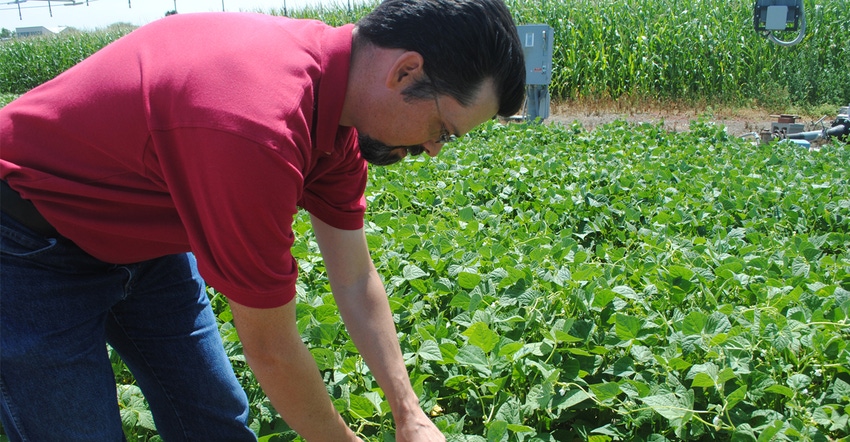
Western bean cutworms can do a fair share of damage to dry edible beans. Last year, the first WBC moths were caught in University of Nebraska-Lincoln black light traps June 23 in North Platte, June 26 in Clay Center and July 7 in Scottsbluff.
Typically, dry bean growers gauge their risk levels within their fields by understanding cumulative moth counts from the beginning of the season to the peak moth flight, with 0 to 700 moths considered low risk; 700 to 1,000 moths at moderate risk; and anything over 1,000 moths considered high risk.
At a recent virtual Nebraska Extension dry edible bean day, Jeff Bradshaw, Extension entomologist and interim director of the UNL Panhandle Research and Extension Center, told growers about WBC studies conducted in the Panhandle in 2020 related to insecticide timing and trap accuracy.
Type of trap
Moth traps are needed to assess WBC risk levels in the field. One of the most common, inexpensive trap designs used by farmers is the milk jug trap. “It is inexpensive, but it is a mess to go through,” Bradshaw said.
Several other traps are being used, including a trap that includes a camera that captures images of moths that are trapped on a sticky pad, he explained. The moths are counted automatically, and then the numbers are sent digitally. Another digital design electrically zaps the moths, they fall into a bucket, and the images are counted and uploaded digitally.
A less automated design is called the green bucket trap, which is similar to the milk jug trap, but costs a little more to set up. In 2020, UNL conducted random, replicated trials of each type of trap on different sides of the same fields.
Bradshaw said that after hand count verification of the digital traps in the study, the green bucket trap caught significantly more moths over the course of the beginning of the moths being captured through the peak than the other traps. “More moths we would presume to be more correct data,” he said.
Capturing more moths means quicker response to threshold numbers and potential treatment, if necessary, he added. “They may cost slightly more than the milk jug trap, but it might be worth it if we can prove those numbers are more accurate," Bradshaw said.
The other interesting thing researchers found was that traps placed on different sides of the three fields being studied captured significantly different numbers of moths. While the numbers from each side of each field would be averaged to get an overall average for the field, this does raise questions about the effect of adjacent crops to a field edge, as well as topography, on WBC infestations.
“In one field, one side of the field had 1,500 moths, and the trap on the other side had less than 500,” Bradshaw said. “This is why you always want more than one trap in each field, and you want to be cautious about where you put the trap, so you get a true representation of your risk.”
Treatment timing
The second part of 2020 studies included insecticide timing trials. While some growers might be tempted to tank-mix insecticide treatments with earlier herbicide treatments as insurance, Bradshaw said that their UNL studies found that timing is important, and treatments should not be made unless they are needed.
In addition to a control, fields were treated with Asana insecticide at a rate of 2.5 ounces per acre with hand booms in two different timings. One treatment was made on test strips before bean canopy closure, while another treatment was made on different test strips at the normally recommended treatment time of two weeks after peak WBC flight.
While there was not much difference on average between the control and the insecticide-treated test strips, over all the fields the recommended timing of treatment two weeks after peak flight experienced less pod damage than the earlier treated strips.
“If you treat too early, you might be shooting yourself in the foot,” Bradshaw said. “It was the same result in each field. There is a production risk due to off timing of the insecticide application. We need to time the treatment post peak flight if we want to maximize the effectiveness against WBC, because the early treatment reduced the natural enemy populations of WBC, opening up the risk to infestation by knocking out the beneficial insects.
“Careful, judicious use of pesticides in general reduces the chances of resistance as well,” Bradshaw noted. “If you want to maximize revenue, only apply when needed, and make it well timed to maximize WBC mortality. Target the right life stage.”
Bradshaw said well-timed applications will conserve natural enemy populations of WBC longer, which can help out with spider mites as well. It slows insecticide resistance in WBC, so growers should only use insecticides when needed.
Learn more by contacting Bradshaw at [email protected].
About the Author(s)
You May Also Like






